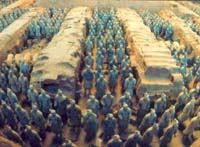 Xi'an OverviewIn ancient times the city of Xi'an was a major crossroads on the
trading routes from eastern China to central Asia, and the
beginning point of the famed Silk Road; in recent years this 3,100
year old city that was once regarded to be on a par with Rome and
Constantinople, has come back into its own as one of China's major
tourist attractions. In 1974, on the city's eastern outskirts, archaeologists
stumbled across a treasure trove: an army of terracotta warrior
figurines in battle formation standing in underground vaults.
Hailed as the greatest archaeological find of the 20th century, the
Terracotta Warriors of Xi'an have brought visitors from around the
world flocking to the city to soak up its historical and cultural
heritage, and perhaps embark on an adventure tour along the ancient
silk caravan route. Xi'an, in ancient times known as Chang'an, is situated in
central China in the southern part of Guan Zhong Plain in Shaanxi
province, with the Qinling Mountains to the north and the Weihe
River to the south. Besides the terracotta warriors, the city has a great many
historical relics of interest including museums and temples, having
been the capital city of China through 12 dynasties during its
thousands of years of development. The city wall is the largest in
the world, and the Forest of Steles, with its collection of more
than 3,000 ancient stone tablets, is both the largest and oldest in
China. |